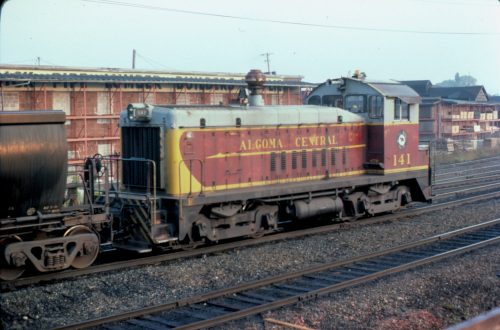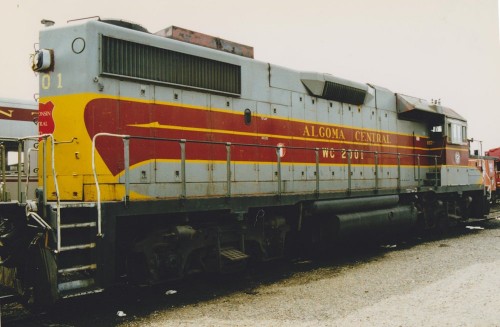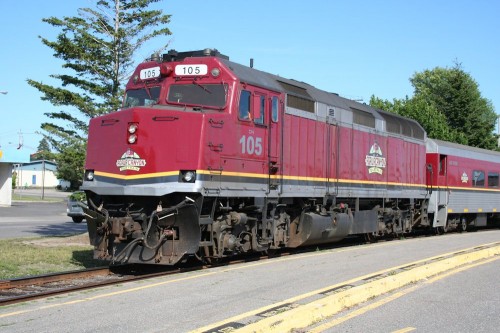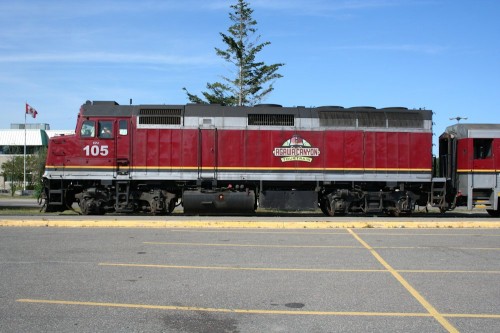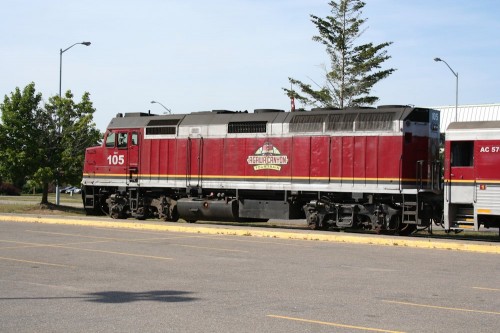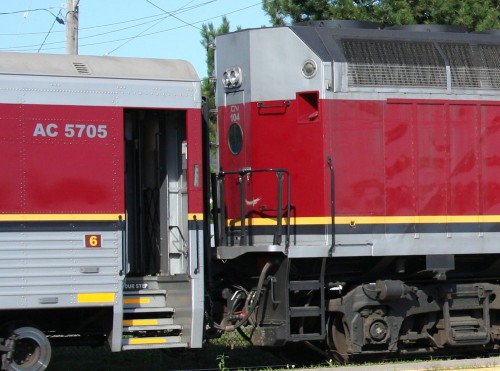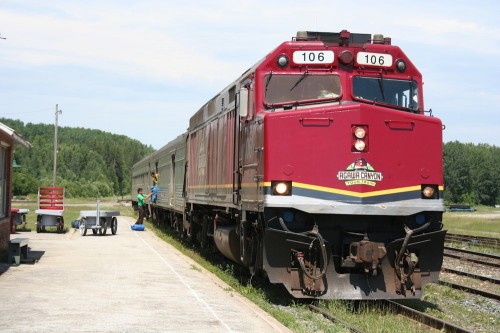Tag Archives: Locomotive
Wordless Wednesday #35
Early Samples of Bowser’s HO Scale Canadian SD40-2 Displayed
This week Bowser posted photos on their website (and also emailed out to various contacts) of pre-production sample models of 11 different variations of their upcoming Canadian SD40-2 HO scale model.
All of the models are patterned after the versions built by General Motors Diesel Division in London, ON and represent the distinctly Canadian features that were unique to units built in Canada (vertical style ladder steps and modified handrails to match) and typical to Canadian railways (headlight in nose, cab front bell, class lights in single or 3-light groups above the number boards, single rear back-up headlight on most versions, railroad specific plow/pilot and ditch light configurations, snowshields (on certain versions) etc.).
Railways and versions represented by the 11 variants include Canadian Pacific (multiple variants), British Columbia Railway (at least 2 versions), Ontario Northland (non-dynamic brake), Quebec, North Shore & Labrador (with extra large fuel tank) and last but not least, Algoma Central. (I foresee an order for six units in my future…)
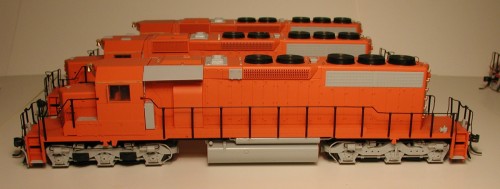
Pre-production sample, HO scale Algoma Central SD40-2. Bowser Manufacturing Company model and photo.
This appears to be the AC version, with a pair of CP versions in the background. (Specific features: single class lights on numberboards, snow plow, RR-specific M.U. electrical connection stands, pilot lift rings, pilot mounted ditch lights, snowshields, flat-top radiator and dynamic brake fans, electrical contact access doors on side of dynamic brake housing, straight turbo exhaust, wire radiator grilles, single rear backup headlight.)
Check out the photos of all 11 versions on Bowser’s web site here:
Atlas 2014 Catalog and Announcements – HO AC GP38-2
Earlier this week, Atlas Model Railroad Co. posted their 2014 All-Scales Catalog. Inside the HO Scale Announcements section is an interesting item for Algoma Central fans: Algoma Central is one of the roadnames in the next upcoming release of their TrainMan series GP38-2.
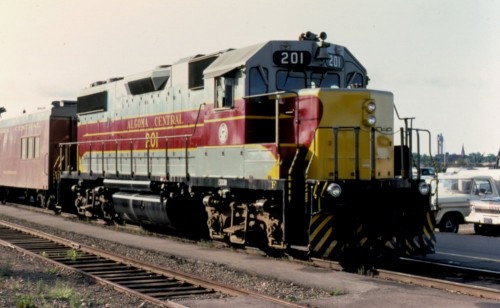
AC 201 at Sault Ste. Marie in September 1982. Francis J. Wiener photo, Chris van der Heide collection.
Several years ago, Canadian Hobbycraft had sponsored a custom run of GP38-2s in various Canadian paint schemes including less common shortlines like RaiLink and Algoma Central. These were produced using the Life-Like Proto2000 GP38-2. Of course this limited run has long been out of production, and while one or two might pop up on the secondhand market occasionally, new ones just aren’t available anymore.
The new Atlas model is in the TrainMan series, which is Atlas’s more “entry level” line; the model will have the same proven drive train as Atlas’s higher end “Master Series” but the body may have less of the fine detail, and it most likely won’t have the road-specific details like snowplow, nose headlight, cab front bell, single rear headlight, Canadian-style vertical steps etc. However this will still be a good enough stand in for most, and a good starting point for detailing for many others.
They currently list road numbers 200 and 202, although this could potentially still change before production. The prototype locomotives were built in 1981 by General Motors Diesel Division in London, ON as series AC 200-205. Most or all of them are still operating today (just not in ACR colours) as WC 2001-2006.
Part of the ad copy in the catalog indicates matching cabooses will be available, and indeed, further down is a section with new paint schemes on the TrainMan series “steel cupola caboose”, including Algoma Central. Of course this model is based on a small north-eastern US prototype that isn’t remotely similar to any ACR cabooses. The catalog outline artwork shows a caboose numbered AC 9607; this number would correspond to one of the three ex-CP vans acquired in 1992-93. Rapido Trains produced a model of this caboose several years ago. Highball Graphics also has some ACR caboose decals that can be used to custom paint something a bit better than the TrainMan caboose into ACR colours.
One other announcement in the catalog which will be of significant interest to most Canadian modelers is not too much of a surprise: a new version of their 50′ NSC boxcar matching the features of cars owned by Canadian Pacific and Ontario Northland. (Previously they have run Canadian National and British Columbia Railway versions.)
The first run of this version contains three paint schemes: Ontario Northland (7700-7799 series), Canadian Pacific (CPI 85635-85734 series) and Quebec Central/CP* (QC 75100-75299 series). All of the paint schemes represent original factory paint jobs, and future releases of other CP repainted cars are likely in subsequent runs.
* Note: The outline graphics in the catalog show the QC cars as an apparent ex-CP patch job; I checked with Atlas and this is not how the actual cars will be decorated. They will properly represent the as-built appearance of the QC cars, which were built new with QC reporting marks and CP colours. (Quebec Central was a CP subsidiary absorbed in the 1930s. CP re-used the marks in the late 1970s as a method to have empty paper service boxcars routed back to eastern Canada by other roads.)
Build dates for the prototype cars represented by the model are as follows:
| Series | Build Date | Qty. | Note |
| CPI 85635-85734 * # | 9-10/77 | 100 | re# CP /78-/83 |
| ONT 7600-7629 | 11/77 | 30 | |
| ONT 7700-7799 * | 9/80 | 100 | |
| QC 75000-75099 | 11-12/79 | 100 | |
| QC 75100-75299 * | 7-8/80 | 200 | |
| QGRY 75000-75299 $ | 11-12/79, 7-8/80 | 81 | ex-QC /98 |
* – Series represented by Atlas
# – Previous series CPI 85500-85634 (Built 3-5/75, 135 cars) are similar but have 10′ wide doors (vs. 9′ doors on all of the other above) and non-cushioned underframes
$ – QGRY series is non-inclusive.
Some woodpulp/paper traffic from mills on the CPR line on the north shore of Lake Superior routed over the ACR from the interchange at Franz (that’s a subject I may attempt to cover in more detail sometime in a dedicated post), and there’s evidence that some paper from the Ontario Northland (from mills at Iroquois Falls, and likely from Kapuskasing and Smooth Rock Falls following the takeover of the ex-CN Kapuskasing subdivision) so any of these cars would not be out of place on a period ACR layout. I’ll be getting a couple of these cars for sure to mix into my CP woodpulp/paper fleet.
ProtoFile: Agawa Canyon Tour Train F40PH Locomotives
In 2009, CN acquired the equipment that had been in use on the former Ski Train out of Denver, Colorado. This purchase consisted of 3 ex-Amtrak F40PH locomotives and 14 coaches, which ironically were originally built in 1968 for CN where they saw regular service on the Toronto-Sarnia/Windsor corridor.
Initially pushed into service in 2009 still in their old yellow-orange Ski Train colours, the equipment was extensively refurbished in 2011-2012 and repainted into a handsome new interpretation of the Algoma Central’s traditional wine red and grey passenger colours.
The red main body on the locomotives and cars are nicely accented by a yellow and black stripe and a grey lower body and roof. The lettering used for the road numbers (and the small CN logo above the number) is a light grey.
Part of the refurbishment of the equipment included TV display screens in the coaches featuring a live cab view transmitted from a camera in the engine. Look closely in the windshield of the 104 in the below photo, or the 105 in the photo at the top of this post and you can see the video camera mounting next to the centre divider between the two front windows.
When we come to the rear of the units, close observation reveals a couple of minor differences.
While on CN 105 (the first unit refurbished and repainted into the new colours in 2011) above, note that the black along the angled part of the roof also carries directly across the end of the locomotive, and the unit’s road number in grey is lettered at the top of the carbody, above the read headlight.
On CN 104 (and 106 exhibits the same pattern – these two units were repainted in 2012) note that the black does not carry over onto the end of the unit, and instead of a large road number at the top of the body, there is a small CN logo and number below on the headlight, on the door.
During the peak fall colour season, all three units are used together on the tour train. When I was in the Sault at the end of September, the Agawa Canyon Tour Train ran north with 105 and 104 on the head end, and 106 bringing up the rear. At Canyon, the 105-104 had run around the train and the tour train returned to Sault Ste Marie with all three units in consecutive order on the head end, 104-105-106.
Having units at each end of the train means that there is always a unit coupled to the coaches to provide electrical power at Canyon. (And also there is no way to turn an engine at Canyon.)
During the slower summer season, the Tour Train runs with one F40PH at each end (and returns south in this configuration with no runaround at Canyon). During this season, the unused third unit is freed up to provide locomotive power to the regular passenger service.
These three units were all originally built for Amtrak in 1977-1978. They were built by GM’s Electro-Motive Division (EMD) and given the model designation F40PHR, with the ‘R’ indicating that these units were built at least in part using in parts from SDP40F locomotives that Amtrak was replacing in the 1970s. Otherwise these are the same as a standard F40PH.
The three locomotives were sold to Ski Train in 2000, where they operated until the spring of 2009 and were acquired for the Algoma Central Railway.
| CN # | Model | Builder | Date | Serial | Lineage |
|---|---|---|---|---|---|
| CN 104 | F40PHR | EMD | 10/1977 | 777001-13 | ex-SKTX 242, ex-AMTK 242 |
| CN 105 | F40PHR | EMD | 4/1978 | 777063-4 | ex-SKTX 283, ex-AMTK 283 |
| CN 106 | F40PHR | EMD | 6/1978 | 777063-10 | ex-SKTX 289, ex-AMTK 289 |

